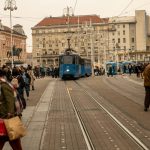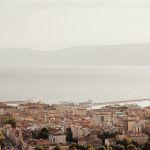Update on progress from the new stretch of the Jelsa – Sućuraj road
I set out for Sućuraj this morning, confident that I would have an easy journey, following the photo of a gleamingly asphalted stretch posted on this blog eleven days ago.

How wrong can one be? Of the 8.5 kilometres under construction, something less than 2 kilometres have been asphalted. The rest varies from relatively smooth caked earth to slippery potholed mud to disastrously treacherous gravel.

While most of the road has been substantially widened, at one point it is reduced to a single track hemmed in by irregular rubble. Crawling along at a top speed of 20 kph, but mostly less, I had time to consider the situation.

I was surprised that men and machines were taking a rest on a Saturday morning, presumably for the whole weekend, which probably means a re-start late Monday morning when the workers get back from the mainland. Given the amount there is left to do, one would expect work to be continuous now that the tourist season is getting under way. There was in fact one man at work, doing important things with a shovel round one of the large new drainage pipes. Essential work, no doubt, but not likely to speed up completion of the asphalting.

It is not clear what logic is dictating the pace of the works. This was also the case in the widening of the Pitve road: around Christmas there was a spell when the work was being carried out day and night; then there was a costly pause, which meant the road was not finished when it was urgently needed, for the Easter Processions. Rumour had it that the Pitve road would be finished before the elections, to please the voters. Whether or not it was a political ploy, the road was indeed finished in time for the elections, but was that enough to make up for the long months of inconvenience and expense endured by all the residents and visitors trying to get from Jelsa to Pitve and the south side of the island via the old tunnel?

Work on these 8.5 kilometres of the Sućuraj road started before the Pitve widening. In both cases, there are worries that the new flat expanded stretches will encourage hotheaded drivers, whether young, inexperienced or old enough to know better, to drive at excess speeds or race each other. Given that the roads are still winding and it is all too easy to lose control of a speeding vehicle, there is an increased danger of accidents.

The most surprising aspect of these major road improvements is the missed opportunity to create something Hvar roads urgently need. There is not a single main road on Hvar with a pavement for pedestrians or a cycle track. The reconstructions of the Pitve and Sućuraj roads have failed to address this. Are we in the 21st century? Are we aspiring to European standards? Surely the planners should have taken into account the needs of all road users, not just what suits vehicles. Cycling and walking holidays are an important part of Hvar’s tourism and must be properly catered for.

The new parts of the Sućuraj and Pitve roads have been created at a damaging cost to the environment with the loss of trees and related wildlife habitats. It remains to be seen how much of the island’s transport problems are eased through these projects, and whether new problems will arise as a result of them.

Best advice to all drivers on Hvar:
1. avoid driving on the Jelsa – Sućuraj road until it is completed and fully opened;
2. drive patiently at all times, don’t take risks;
3. if you are driving a large slow vehicle, pull over to let others pass you whenever possible;
4. always be prepared to give way to oncoming vehicles;
5. be aware of others on the road: drive considerately when passing cyclists, pedestrians or animals.










